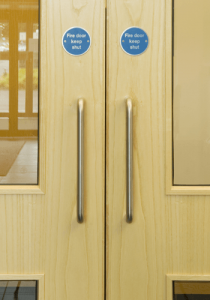Recently added item(s)
You have no items in your basket.

In the first part of our Passive Fire Protection blog ‘Fire Doors – Better Safe than Sorry’, we talked about the critical role that fire doors play in fire safety and saving lives.
But while the fire door itself has an important job to do in the event of a fire, it will only be effective if all the components of the fire door, and not just the door itself, are up to standard and can provide a fire and smoke tight compartment.
A recent survey of fire door inspections revealed that 61% of the doors inspected had issues with fire/smoke seals, 25% had problems with hinges and 1 in 6 had problems with the door leaf, so making sure your fire doors and all the components are 100% compliant is crucial to their performance in case of a fire.
Whether you are fitting new fire doors or undertaking routine inspection and maintenance, the key things to check are as follows:
1. You have an accredited fire door together with CE marked and accredited door furniture (hinges, latches, screws etc) and mechanisms like closers.
It is worth noting that not all doors are compatible with all components, and not every door fits every door frame, so check the manufacturer’s instructions and fire certificate and make sure you have the right door furniture and frame to work with your fire door. If not, it will invalidate any fire certification and you cannot be sure that the door will operate safely.
2. The door fits the door frame and there are appropriate gaps and either intumescent strips or intumescent smoke seals around the frame and door.
For your door to work well on a day to day basis it will need to have a consistent and equal gap around the door, usually advised by the manufacturer to be 3-4mm. You can measure this accurately by using a gap tester. These are available free from many sources such as BWF-CERTIFIRE.
When there is a fire however, it is important that there is no gap between the door and the frame for the fire or smoke to spread through. To achieve this, you need to fill the gap with a fire stopping material, like intumescent strips or combined intumescent smoke seals, which expand as a reaction to heat. This should ensure that fire will not get through any gaps into the rest of the building for the duration of the fire door’s guarantee time, so for example a fire door rated FD30 equals 30 minutes and a fire door rated FD60 equals 60 minutes (this door is used in most public buildings such as schools, hotels and offices).
3. The door must open and close properly, ensuring the door and door frame are positioned appropriately.
The mechanism used to close the door must be CE marked and approved by an accrediting body. It also needs to be the correct mechanism for the weight of the internal fire door so can it can open and close correctly, close in controlled way and onto a latch, or close onto door stop if there is not a latch.
4. Check the supporting construction around the door. Normally the wall (whether brick, block, masonry, timber or steel stud) should provide at least 30 minutes’ fire resistance but avoid having glazed panels above a fire door as they will render a fire door unfit for purpose.
5. One final point to consider. Passive fire protection - such as fire doors - is quite often installed by tradespeople outside of the fire industry and if installed incorrectly means the protection will not work in case of a fire in terms of compartmentalization. Also, be aware that accidental damage to fire doors and the areas around them may be done by other tradesmen who then don’t make good and restore the seal.
Fire Door Safety Week is taking place from 25 September to 1 October. For further information and for hints and tips on keeping your fire doors compliant, visit the website.
Life is precious and property and assets matter. For help and advice on all fire protection and safety products, please contact the Fire Depot team on 0330 999 2233, email us at sales@firedepot.co.uk or visit www.firedepot.co.uk to see our range of fire safety products.